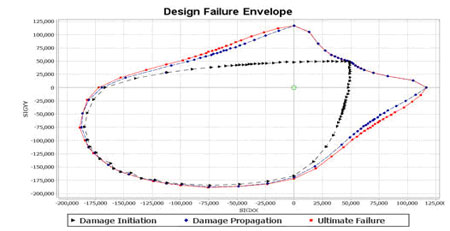Material Characterization
複合材進展性損傷/破壊評価解析ソフトGENOA/MCQ -機能情報
GENOA-Material Characterization
Material Characterization of Tape, and 2-D/3-D Braided/Woven Compositesf
An important part of certification planning is to conduct complete material characterization to assess composite laminate response considering “as-built” and/or “as-is” material states: manufacturing anomalies (i.e., void size/shape, fiber waviness, interphase coating), design (i.e., ply orientation, thickness, 2D/3D architecture). Composite are being used in aerospace, automotive, wind turbine, ship building, and infrastructure industries. It is important to identify root cause for composite damage and failure thru comprehensive material characterization that involve;
- Reverse engineering of constituent fiber and matrix properties;
- Determination of material design envelope;
- Determination of material response under in-service environments including temperature and moisture loading;
- Generation of carpet plot to provide alternate laminates for design consideration;
- Generation of A- and B-Basis strength allowables;
- Accelerate material selection for use in certification;
Objective
Provide material and structural engineers with verified capability for rapid and accurate assessment of laminate response under in-service loading.
Approach
Use GENOA’s MCQ module integrating micro and macro-mechanics with damage tracking by assessing physics based damage and failure criteria encountered in composites. Material response is interrogated to determine loads that produce matrix cracking under tension, compression, shear, and fiber failure under tension and compression (including crushing, fiber-matrix debonding, and fiber micro-buckling) are evaluated. Analyst has a choice of using fiber/matrix or ply properties as input to the analysis. MCQ does not use finite element theory, rather it uses nit cell approach depicting ASTM specimen with uniform state of stress.
Tools Used
GENOA’s MCQ module are used for:
- Fiber, Matrix, and Lamina Calibration – Reverse engineer effective linear fiber/matrix properties from lamina or laminate test data (strength and stiffness). The effective properties accounts for the thermal residual stresses and interface due to curing process.
- Non-Linear Material Characterization Optimization (MCO) – Reverse engineers effective fiber, matrix, ply non-linear properties (stress strain curves) from ply or from laminate test data.
- Ply Level Analysis – Predicts equivalent ply properties (mechanical/thermal/electrical) using fiber matrix properties as input. Example of mechanical properties (Figure 1) is ply strength in 11, 22, 33, 12, 23, and 13 directions. Example of electrical properties is ply and laminate conductivity.
- Laminate Analysis – Predict equivalent laminate properties using fiber/matrix or ply properties as input. The properties calculated include laminate strength and stiffness, and electrical and thermal properties as well.
- Design Failure Envelope – Predicts design failure envelope for chosen failure criteria for laminates. Strength, strain, and interactive based failure mechanisms are available (Figure 2). Fiber failure under tension/compression including micro-buckling, matrix cracking under tension and compression and delamination (in-plane and out-of-plane) are determined for the ply and the laminate. Several Failure Criteria can be compared for better understanding and comparison against test data.
- Ply Characterization – Graphically shows variation in strength as a function of ply orientation and fiber or void volume ratio.
- A- & B- Basis Allowables – Predicts equivalent ply properties (mechanical/thermal/electrical) using fiber matrix properties as input. Example of mechanical properties (Figure 1) is ply strength in 11, 22, 33, 12, 23, and 13 directions. Example of electrical properties is ply and laminate conductivity.
- Ply Level Analysis – Rapid and accurate prediction of A- and B-basis strength allowables for un-notched uniformly stressed coupons. This module provides the option of predicting allowables from a minimal number of test replicates. With a dedicated sensitivity analysis one can determine the influence of manufacturing parameters and material properties on the laminate strength. This helps reduce the scatter and improve the performance of the material (Figure 3 & 4).
- Parametric Carpet Plots – Carpet plots identify laminate percentages (regions) that are governed by fiber failure dominance, by matrix cracking (transverse and shear) dominance and by combined fiber/matrix failure. The applications and benefits include reducing the number of laminate coupon tests required to verify the entire range of 0°, +/-45° and 90° percentages.
Benefits Provided
- Facilitates material selection and material qualification
- Provides alternate laminate designs
- Generate composite input for commercial FEA solvers (NASTRAN, ABAQUS, ANSYS and others)
- Determine strength allowables with reduced testing
- Assess effect of manufacturing defects and environment on material response
- Reduced testing
- Accelerate certification
Past Experience
Capability was used in qualifying several classes of carbon and glass composites for aerospace and automotive applications.

MCQ Generated Ply Properties

Design Failure Envelope Progression for a [0,90,45,-45] Symmetric Layup

Material Performance Envelope Generated by the Software
Reference
DOT/FAA/AR-03/19, Final Report, “Material Qualification and Equivalency for Polymer Matrix Composite Material System: Updated Procedure” Office of Aviation Research, Washington, D.C. 20591, U.S. Department of Transportation Federal Aviation Administration, September, 2003.

Carpet Plot of Laminate Strength as Function of 0, 45, and 90 degrees Ply Angles (Red = Fiber Failure, Green = Matrix Failure, Blue = Matrix Shear Failure)

